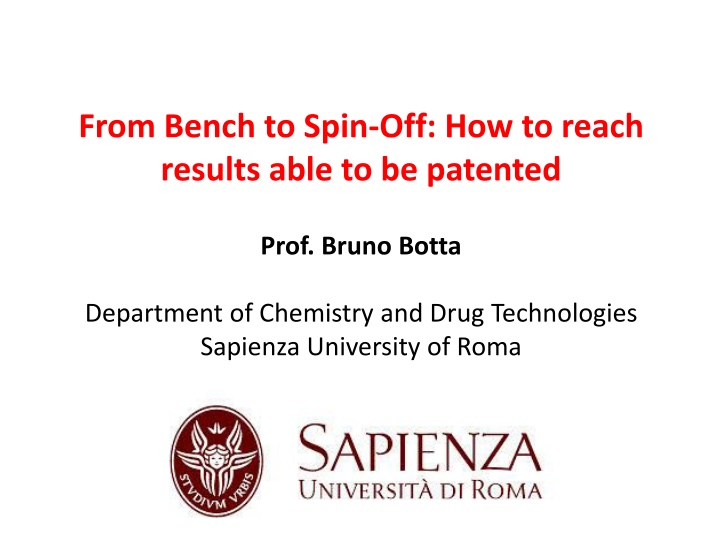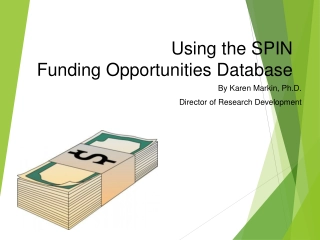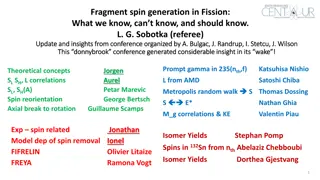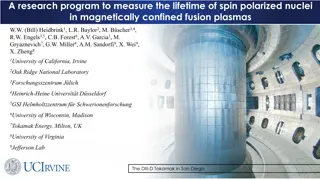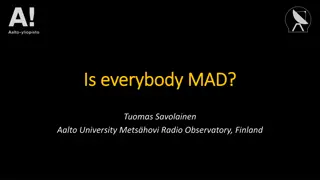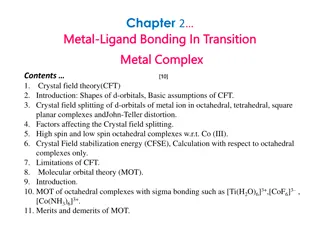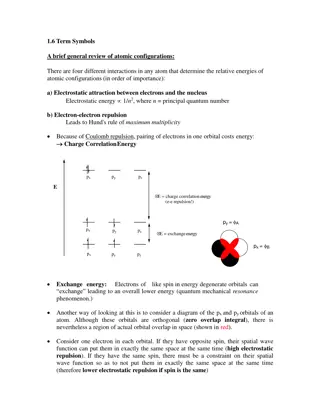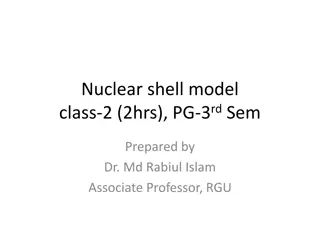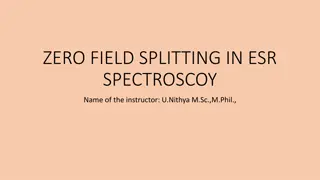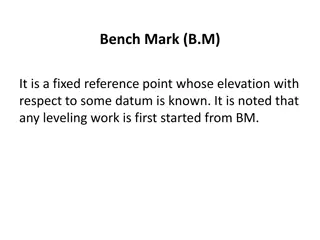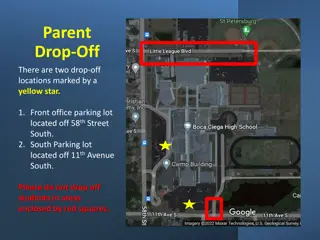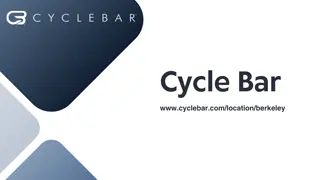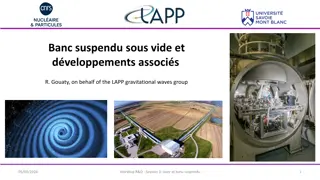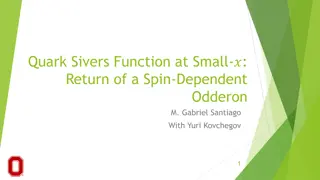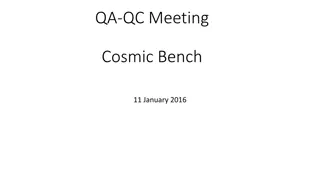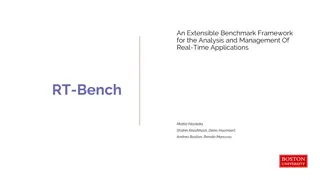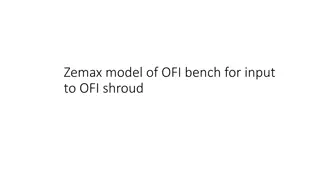From Bench to Spin-Off: How to reach results able to be patented
Molecular Links Rome is a spin-off company of the University Sapienza of Rome specializing in Chemistry & Biotechnology. They focus on collaboration agreements, profit share contracts, and joint research projects with innovative PMIs and academic centers. Their services include proprietary separation/purification techniques, natural products libraries, enzymes and bioreactors, and an advanced in silico screening platform. They also work on histaminase from vegetal origin, DAO production, diagnostic tests for halitosis in saliva, and biogenic amines quantitative determinations in beverages. Additionally, they explore Ferritin-based scaffolds for nanotechnology applications such as drug delivery and diagnostics, utilizing recombinant human ferritins and thermostable ferritins for nanodot/nanophosphor development.
Download Presentation

Please find below an Image/Link to download the presentation.
The content on the website is provided AS IS for your information and personal use only. It may not be sold, licensed, or shared on other websites without obtaining consent from the author.If you encounter any issues during the download, it is possible that the publisher has removed the file from their server.
You are allowed to download the files provided on this website for personal or commercial use, subject to the condition that they are used lawfully. All files are the property of their respective owners.
The content on the website is provided AS IS for your information and personal use only. It may not be sold, licensed, or shared on other websites without obtaining consent from the author.
E N D
Presentation Transcript
From Bench to Spin-Off: How to reach results able to be patented Prof. Bruno Botta Department of Chemistry and Drug Technologies Sapienza University of Roma
Molecular Links Rome is a spin-off company of the University Sapienza of Rome. Chemistry & Biotechnology
Networking with innovative European PMIs Collaboration agreements, profit share contracts, joint research projects with innovative PMIs and top level academic centers are at the basis of our business concept. MOLISA Molecular Links Sachsen-Anhalt
MoLiRom s.r.l. Molecular Links Rome Proprietary separation/purification techniques Natural products libraries Enzymes and bioreactors Advanced in silico screening platform Networking with innovative European SMIs
HISTAMINASE (DIAMINE OXIDASE, DAO) FROM VEGETAL ORIGIN New active ingredient for food intolerance linked to histamine release from gut Formulated as food grade powder Possible indications for irritable bowel disease
DAO PRODUCTION Continuous centrifuge Ambient chamber Batch + Fine (akta) Cromatographic purification Seedlings care Extraction IMPROVED PILOT FACILITY 2-4 Million Units / year
Other DAO applications Diagnostic test for halitosis in saliva (detection of biogenic amines). Dry chemistry device. ANd9GcRgTbWMHPVbBeJOs7VhW_2c5eN9Xjs5QqOOhhp1fBd1QT-DcCrqvFvrAQ Biogenic amines quantitative determinations in wine and beer, colourimetric analysis: Key parameters for quality beverages ! ANd9GcRgTbWMHPVbBeJOs7VhW_2c5eN9Xjs5QqOOhhp1fBd1QT-DcCrqvFvrAQ ANd9GcQzICyF-uRJDR3u_x90ulMDzoXvZrURn8ZlZruPmP0r1nOdKWYQlc8doHg ANd9GcQwcfX15TLV5HEXIlaRRdLMPERoEkl8BsvxSnvwCuQ-ePjAqBhWcNMxMA
FERRITIN BASED SCAFFOLDS FOR NANOTECHNOLGY - Recombinant human ferritins for drug delivery and diagnostics - Thermostable ferritins for nanodot/nanophosphors assembly
Proprietary separation/purification technologies Capillary I.D. [150-530] m Nano I.D. [20-150] m I.D. 1.0-2.0 mm I.D. 4.00 mm I.D. 4.00 mm SPE cartridges MOnoLithic HPLC Columns Separation/purification of drugs, metabolites, pesticides, bioproducts, plasma proteins
Analysis of Erythropoietin Monolithic Column 40-ACR-RP-MD-08-06A 250x0.250 mm 20 Erythropoietin [c]:0.500 mg/ml 15 10 60% B mAU 24.5 25.0 25.5 26.0 26.5 27.0 27.5 5 ? 5% 0 0 5 10 15 20 25 Minutes 30 35 40 45 50 55 Eluents: A: H2O/ACN 95/5 V/V+0,1% TFA, B: H2O/ACN 5/95 V/V+0,1% TFA; Flow rate: 15.000 L/min; P: 132 bar Pump: Dionex Ultimate 3000; Cell: 20nl; Vinj: 200 nl; T: 60 C, UV@214nm
Analysis of Erythropoietin Packed Column ACE C4 3 m 300 150x0.300mm 80 Erythropoietin [c]:0.500 mg/ml 60 80% B 40 mAU 20 ? ? ? 10% 0 0 10 20 30 40 50 Minutes Eluents: A: H2O/ACN 95/5 V/V+0,1% TFA, B: H2O/ACN 5/95 V/V+0,1% TFA; Flow rate: 3.000 L/min; P: 34bar Pump: Dionex Ultimate 3000; Cell: 20nl; Vinj: 200 nl; T: 60 C, UV@214nm
Separation of Protein Mix 40-ACR-RP-MD-37 column: 250x0.200mm 3 2 70 %B 4 1.Ribonuclease A (0.0413 mg/ml) 2.Lysozyme (0.0421 mg/ml) 3. -Lactalbumin (0.0397 mg/ml) 4. Myoglobin (0.0405 mg/ml) 5. 5. -Chimotrypsinogen (0.0413 mg/ml) 6. Ovoalbumin (0.0889 mg/ml) 50 1 6 5 0 Total amount injected: 58.5 ng 0 10 20 30 Minutes Sample tR k app (l) 11.26 16.22 18.36 19.70 20.42 24.44 PWHH* (min) 0.11 0.10 0.11 0.14 0.11 0.15 Napp/col Asymmetry Factor (l) 1.34 1.15 1.40 1.51 1.37 1.05 Resolution (l) - 25.39 10.42 5.55 3.07 16.50 (min) 10.91 15.33 17.23 18.42 19.06 22.64 (s) 6.6 6.0 6.6 8.4 6.6 9.0 ( l) 0.99 0.90 0.99 1.26 0.99 1.35 1 2 3 4 5 6 Ribonuclease A Lysozyme -Lactalbumin Myoglobin -Chimotrypsinogen Ovoalbumin 58486 131564 125013 97486 173051 128787 Eluents: A: H2O/ CH3CN, 95/5, v/v + 0.1% TFA; B: H2O/ CH3CN, 5/95, v/v + 0.1% TFA; Flow rate: 9.000 L/min; Pump: Dionex Ultimate 3000; Detection: UV @ 214 nm; UV Cell 20 nL ; T: 60 C
Analysis of Total Protein Extract of Human Neuroblastoma Cells by capLC 40-ACR-RP-MD-08-06 column: 550x0.250mm 20 Sample: Total Protein Extract of Human Neuroblastoma Cells [c]: 3.57 mg/ml 15 45% B 10 mAU 20% 5 10% 0 0 10 20 30 40 50 60 70 Minutes Eluents: A: H2O/ACN 95/5 V/V+0,1% TFA, B: H2O/ACN 5/95 V/V+0,1% TFA; Flow rate: 10.000 L/min Pump: Dionex Ultimate 3000; Cell: 20nl; Vinj: 500 nl; T: 60 C, UV@214nm
Natural products libraries Over 900 bioactive natural products have been identified and characterized. These products can be made available for screening in pharma industry in the form of panel plates. De novo synthesis is also available.
Our molecular modeling strategy in drug design The Structure of the target receptor is available (X-ray, NMR, homology modeling) no yes Ligand-based approaches Structure-based approaches (Chemoinformatics, clustering of compounds library) (Virtual screening, rational design, Molecular Dynamics)
Example of Structure-based approach Hedgehog inhibition Natural products library (in house) 850 ca molecules DOCKING Free Energy calculations ZF5 ZF2 ZF1 ZF4 ZF3 GlaB active in vitro and in vivo EMBOJ (2015) 34(2):200-17.
GlaB inhibits Gli1/DNA interaction in vitro and in vivo EMBOJ (2015) 34(2):200-17.
GlaB efficacy in vivo (Ptch1+/- MB allografts) MB CSCs 30 mg/Kg MB orthotopic xenograft animal model confirmed the efficacy of GlaB in vivo (GlaBcrosses of mice BBB) EMBOJ (2015) 34(2):200-17 WO 2014207069 Preclinical studies in GLP are running .
Derris Glabrescens Seeds extraction soxhlet MeOH Products isolation silica-gel chromatography 5% AcOEt/benzene 19 18 17 1 7' 8 16 MeO O 2 3 15 7 910 O 6 4 5 11 OMe 5' O 14 O 12 total synthesis 13 20 4 21 GlaB Capsules 100 mg Glabrescione B 0,3% 22 23 24
Example of Structure-based approach Mtb PtpB inhibition Natural products library (in house) 850 ca molecules DOCKING Free Energy calculations Mtb PtpB Kuwanones Mascarello et al. PLoS One. 2013;8(10):e77081
0 M (), 1 M (), 3 M (), 6 M (); pNPP substrate IC50 = 1.9 0.5 M (Ki = 1.6 0.1 M) Kuw-E is a COMPETITIVE inhibitor of mPtpB Mascarello et al. PLoS One. 2013;8(10):e77081
Example of Ligand-based approach Aim: targeting the Notch3 signaling pathway Note: there are no structure of Notch3 targets available in the Protein Data Bank. In vitro screening may be preferred to computational screening. However, HTS are generally time and cost consuming and should deal with false positives.
How is it possible to concentrate in vitro efforts only to a limited number of representative compounds? To cluster a compounds library based on molecule s common chemical structure (Fingerprints comparison) and to select the cluster s head as the most representative molecule for each cluster Mauser H, J Chem Inf Model 2005, 45, 542-548
Clusterization of the whole library Clusters Cluster representative Molecules of the cluster
Cluster Representatives TESTED AT ROUND #1 POSITIVE HITS ACTIVE AT ROUND #1
Clusters TESTED AT ROUND 2 ALKALOIDS CHALCONES COUMARINS CLUSTERS OF THE REPRESENTATIVE BIOACTIVE LEADS Structure-Activity Relationships (SAR) Hints for Lead Optimization
Clustering of an in house Natural Products library # mols in cluster # clusters Fingerprint: TREE (OpenEye) Tanimoto CutOff: 0.5
10 Most Populated Clusters of Natural Compounds A FERRUGININEs B BENZOPHENONES C CALCHONES OH OH O CH3 OH OH O D CUMARINES OH H3C O H3C OH HO OH HO OH H3C CH3 O O H3C CH3 CH3 CH3 F KUWANOLS G ALKALOIDS E LUPANES H ANTHRAQUINONES H N CH3 HO OH CH3 HO OH O OH CH3 HO N O H H CH3 OH O H3C OH H3C CH3 H O HO H CH3 OH H2C H3C L XANTONES H3C CH3 O OH I IRIDOIDS H O O OCH3 OH O H
Anti-proliferative effects Linea cellulare umana di T-ALL Molt3 Human T-ALL cell line (Molt-3) 20 CTR 18 A 16 B ! 14 Cellularit (X 105) Cell viability C ! 12 D ! 10 G 8 H 6 I 4 L 2 0 0 h 0 h 24 h 48 h 72 h tempo in ore 24h 48h 72h Tempo& in& ore! Compounds were first tested for their anti-proliferative effect on Molt3 cells
Notch3 modulation Human T-ALL cell line (Molt-3) Compounds able to inhibit Molt-3 proliferation and to modulate Notch3 signaling (C, H, L) were classified as POSITIVE LEADS. Respective clusters of positive leads were tested to afford SAR and to drive lead optimization.
NOTCH3 modulators under development C CALCHONES OH O R1 R3 R2 I IRIDOIDS R1 H O L XANTONES O OH O H O OR1 R2
Scientists at MoLiRom Bruno Botta, PhD Professor of Organic Chemistry Email: bruno.botta@uniroma1.it Francesco Gasparrini, PhD Professor of Organic Chemistry Email: francesco.gasparrini@uniroma1.it Claudio Villani, PhD Professor of Organic Chemistry Email: claudio.villani@uniroma1.it Alessandra Bonamore, PhD Research fellow in Molecular Biology, Email: alessandra.bonamore@uniroma1.it Alberto Boffi, MD Professor of Molecular Biology Email: alberto.boffi@uniroma1.it
